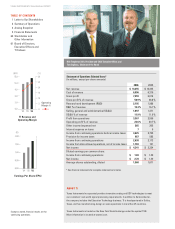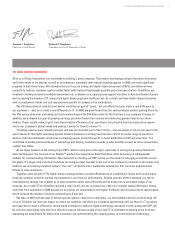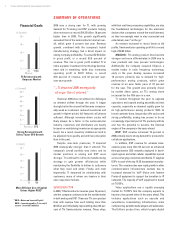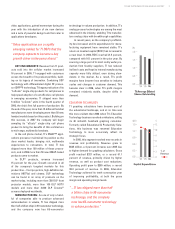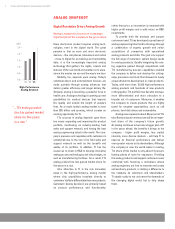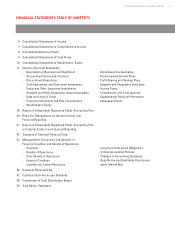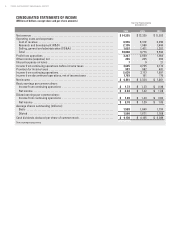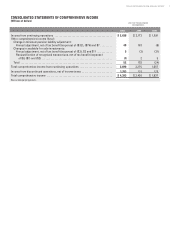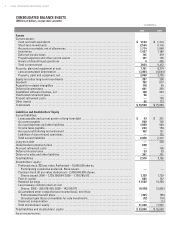Texas Instruments 2006 Annual Report Download - page 5
Download and view the complete annual report
Please find page 5 of the 2006 Texas Instruments annual report below. You can navigate through the pages in the report by either clicking on the pages listed below, or by using the keyword search tool below to find specific information within the annual report.
TEXAS INSTRUMENTS 2006 ANNUAL REPORT 3
video applications, gained momentum during the
year with the introduction of six new devices
and a suite of powerful design tools that cater to
applications developers.
KEY END MARKETS: Revenue from TI prod-
ucts sold into the cellular market increased
16 percent in 2006. TI engaged with customers
across the breadth of its product portfolio, build-
ing on its legacy of innovation. Combining DSP
technology with differentiated digital RF proces-
sor (DRP™) technology, TI began production of its
“LoCosto” single-chip products for cell phones to
help speed adoption of cost-effective cell phones
in emerging economies. TI shipped more than
6 million “LoCosto” units in the fourth quarter of
2006, the chip’s first full quarter of production. By
the end of the year, more than 15 different handset
manufacturers were developing more than 50 new
handset models based on this product. Building on
this success, in 2007 the company will begin
sampling its “eCosto” single-chip cell phone
product to bring the benefits of this architecture
to mid-range, multimedia handsets.
In the cell phone market, TI’s OMAP™ appli-
cations processor maintained its position as the
clear market leader, bringing rich, multimedia
experiences to consumers. In total, TI has
shipped more than 100 million of these proces-
sors, and in 2006 more than 50 new OMAP-based
products came to market.
In DLP®products, revenue increased
15 percent for the year. Growth occurred in all
of the company’s targeted markets for this
product line – front projectors, high-definition tel-
evisions (HDTVs) and cinema. DLP technology
can be found in an array of products on the
market today, including more than 350 DLP front
projector models, more than 100 DLP HDTV
models and more than 3,000 DLP Cinema®
screens deployed worldwide.
MANUFACTURING: As one of only a hand-
ful of companies able to produce advanced
semiconductors in volume, TI has shipped more
than half a billion chips in 90-nanometer technology,
and the company now has 65-nanometer
technology in volume production. In addition, TI’s
analog process technologies are among the most
advanced in the industry, enabling TI to manufac-
ture analog chips with breakthrough capabilities.
In recent years, as the company’s profitabil-
ity has increased and its expenditures for manu-
facturing equipment have remained stable, TI’s
return on invested capital (ROIC) has increased to
a new level. In 2006, ROIC reached 21.5 percent,
compared with 16.1 percent in the prior year. By
sourcing a large part of its most costly wafer pro-
duction from foundry suppliers, TI has reduced
its fixed costs and kept its internal manufacturing
capacity more fully utilized, even during slow-
downs in the market. As a result, TI’s profit
margins have become less sensitive to industry
cycles and changes in customer demand. This
became clear in 2006, when TI’s profit margins
remained relatively stable, despite shifts in
demand.
EDUCATION TECHNOLOGY
TI graphing calculators have become part of
the educational landscape, and at no time was
this more evident than 2006 when TI’s Education
Technology business reached a milestone, selling
its 40 millionth handheld graphing calculator.
Formerly called Educational & Productivity Solu-
tions, this business was renamed Education
Technology to more accurately reflect its
strategic focus.
In 2006, this segment reached new records in
revenue and profitability. Revenue grew to
$525 million, a 4 percent increase over 2005 due
to higher demand for graphing calculators. Gross
profit reached $321 million, or a record 61.1
percent of revenue, primarily driven by higher
revenue, as well as product cost reductions.
Operating profit grew to $200 million, a record
38.0 percent of revenue. In 2006, Education
Technology achieved its tenth consecutive year
of improving profitability, at both the gross
margin and operating margin levels.
“ Video applications are a rapidly
emerging market for TI DSPs that the
company expects to become a key
growth driver in the years ahead.”
“ ...TI has shipped more than half
a billion chips in 90-nanometer
technology, and the company
now has 65-nanometer technology
in volume production.”


